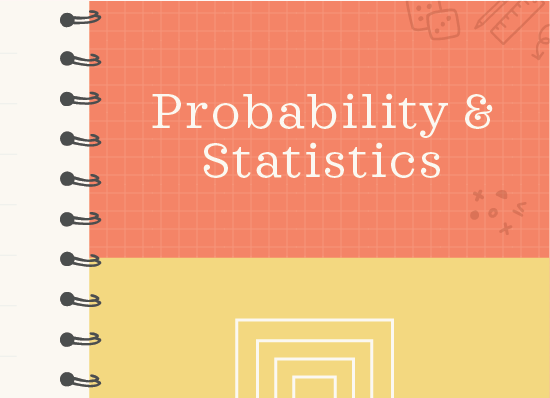Independent and dependent events and conditional probability
Independent and dependent events
Independent probability
Up to this point, we’ve been focusing on independent events, which are events that don’t effect one another. For example, if I flip a coin two times in a row, the result of the first flip doesn’t effect the second flip, so those flips are independent events.
In other words, if I get heads on the first flip, the second flip still has an equally likely chance of producing heads or tails. If instead I get tails on the first flip, the second flip still has an equally likely chance of producing heads or tails.
Hi! I'm krista.
I create online courses to help you rock your math class. Read more.
The multiplication rule
When you want to find the probability of multiple independent events (also called a joint occurrence), you’ll multiply their probabilities. This is called the multiplication rule. So for example, the probability that we get heads twice when we flip a coin two times in a row is
???P(A\text{ and }B)=P(A)\cdot P(B)???
???P(HH)=\left(\frac12\right)\left(\frac12\right)=\frac14???
In other words, the probability of getting heads on the first flip is ???1/2???. The probability of getting heads on the second flip is ???1/2???. These are independent events, so the result of one flip doesn’t effect the other flip. Therefore, the probability of getting heads twice in a row is just a product of the individual probabilities.
We could have also calculated the probability of getting heads twice in a row by realizing that there are four possible outcomes when we flip a coin twice: ???HH???, ???HT???, ???TH???, and ???TT???. The outcome we’re interested in is ???HH???, which means that the probability of getting heads twice in a row is
???P(\text{event})=\frac{\text{outcomes that meet our criteria}}{\text{all possible outcomes}}???
???P(HH)=\frac{1}{4}???
When you flip a coin, there’s a ???50\%??? chance of getting heads, and a ???50\%??? chance of getting tails. But that’s not what makes the events independent. It’s the fact that one flip doesn’t effect any other flip. But let’s say that a soccer player makes ???70\%??? of all penalty kicks that he attempts. In other words, for every ???100??? penalty kicks he attempts, he’s going to make about ???70??? of them.
Given his success rate, we can calculate the likelihood that he makes ???5??? penalty kicks in a row. Each penalty kick is an independent event, since the result of the first kick theoretically has no effect on the second kick, and so on. Therefore, the probability that he makes ???5??? penalty kicks in a row is
???P(KKKKK)=(0.7)(0.7)(0.7)(0.7)(0.7)???
???P(KKKKK)=(0.7)^5???
???P(KKKKK)=0.16807\approx0.17???
Even though the probability that he makes any single penalty kick is ???70\%???, and each kick is an independent event, the probability that he makes ???5??? in a row is about ???17\%???.
Dependent probability
Contrast this with dependent events, which are events that have an effect on one another. Pulling cards from a deck without replacing the ones we’ve pulled would be an example of dependent events.
If we pull one card from a ???52???-card deck, the probability of getting that exact card is ???1/52???. If we set that card to the side without replacing it in the deck, and then pull another card, the probability of getting a specific card is no longer ???1/52???, it’s ???1/51???. Since the probability changed, these are dependent events.
When we talk about dependent events like drawing two cards from a deck without replacing the first, we express that probability as ???P(A|B)??? (read as “the probability of ???A??? given ???B???”), which gives the probability of event ???A??? happening given that event ???B??? has already happened.
When events are dependent, we have to think about the probability of each event.
How to calculate probability with independent and dependent events
Take the course
Want to learn more about Probability & Statistics? I have a step-by-step course for that. :)
Probability of drawing two cards in a row
Example
If we draw a card from a deck of playing cards, and then without replacing it, draw a second card, what is the probability that we’ll get two jacks in a row?
Since we’re dealing with dependent probability, we need to look at the probability of each event. The probability that we get a jack on the first draw is
???P(J_1)=\frac{4}{52}=\frac{1}{13}???
The probability that we get a jack on the second draw is
???P(J_2)=\frac{3}{51}=\frac{1}{17}???
Therefore, the probability that we get two jacks in a row is
???P(J|J)=\left(\frac{1}{13}\right)\left(\frac{1}{17}\right)=\frac{1}{221}???
When you want to find the probability of multiple independent events (also called a joint occurrence), you’ll multiply their probabilities.
If we put this result with the jacks into a formula, we can say that
???P(A\text{ and }B)=P(A)\cdot P(B|A)???
The vertical bar in ???P(B|A)??? means “given”, so ???P(B|A)??? is the probability that ???B??? occurs given that ???A??? has already occurred.
This formula tells us that the probability that ???A??? and ???B??? both happen (that we pull a jack on the first draw and a jack on the second draw) is the product of the probability of the first event happening and the probability that the second event happens, given that the first event already happened.
From this formula, we can prove that events ???A??? and ???B??? are independent if we can show that ???P(A|B)=P(A)???, because this means that the probability of event ???A??? happening is the same as the probability of event ???A??? happening, even if event ???B??? already happened, which means event ???B??? must have had no effect on event ???A???, and therefore that ???A??? and ???B??? are independent. The events are also independent if ???P(B|A)=P(B)???. If this is not true of two events, then they’re not independent events and we call them dependent events.






